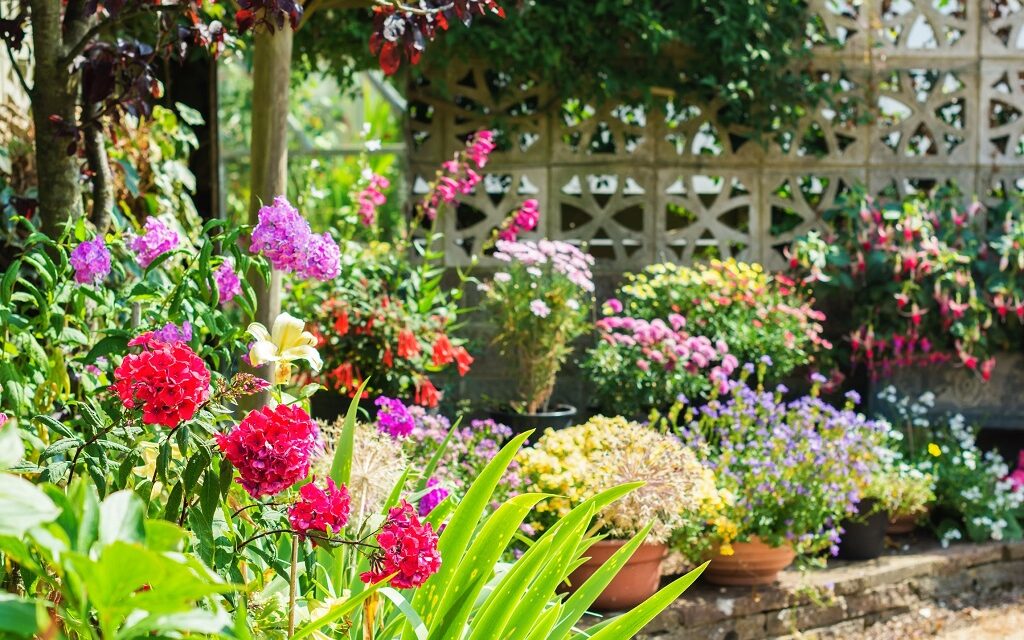Summer is almost coming to a close and we are pleased to reveal that we survived the challenges of critters eating our bounty. Thanks to some science-based hacks, we were finally able to enjoy the literal fruits of our labor, including some beautiful roses, gardenias and plumeria.
Not fans of harsh chemicals and their side-effects, we prefer to deter garden pests from approaching our fruits and flowers by encouraging them to stay away naturally.
From hot chili powder on plants to growing green onions next to our roses, we have learned through trial and error what does and doesn’t work in our Southern California sensory garden.
In this article, we share effective and eco-friendly ways to safeguard your garden from harmful pests and insects, ensuring that your plants can thrive without the use of harmful chemicals.
Table of Contents
- Our “Natural Deterrence” Approach to Garden Pest Control
- Benefits of Choosing Natural Remedies for Pest Control for Your Garden
- 17 Natural Ways to Protect Your Garden Against Harmful Pests and Insects
- Natural Ingredients to Keep on Hand to Protect Your Garden
- Popular Natural Remedies for Common Garden Pests
- Conclusion: Embrace Nature’s Wisdom
- FAQs About Natural Pest Control for Gardens
Also see:
- How to Design a Beautiful Self-Sustaining Permaculture Backyard
- How to Create a Thriving Pollinator Garden with These Plants & Trees
- Dirt Locker: DIY Sustainable Erosion Control Landscaping
- More Recommended Gardening & Landscaping Articles
- Related Topics: Gardening | Landscaping | Lawn Care | Smart Irrigation | Home Wellness
Our “Natural Deterrence” Approach to Garden Pest Control
Our first inclination when disappointedly seeing a half-eaten piece of fruit or bare rose nubs is to wish the death of the unknown, yet despised offending party!

However, after having researched various “eradication” options with their myriad pros and cons, we decided some time ago to take a different approach to pest control for our garden. Instead, we chose to set a goal of making our garden less inviting to the pests we didn’t want, while still being attractive to beneficial wildlife.
Our approach of repelling unwanted pests, while directing them elsewhere, may not be popular with our neighbors, but then again, we would be happy to share our success with them. You can trust that hungry animals and insects will eventually find a spot to dine that is more to their liking, especially with ample wild acreage located nearby.
Our “natural deterrence” approach will continue to be a work-in-progress as there is always something to learn and progress to monitor for our latest tests. In general, our revised, more humane pest control strategy can be segmented into four fronts:
Plant Wellness
The first step in protecting your garden from pests, is to focus on keeping your plants, trees and flowers as healthy as possible. When your plants are given a strong chance to strive, they will be in a better position to fend off routine pests and setbacks, often on their own.
Though we recognize that many people would classify this as “regular gardening”, we make a concerted effort to figure out quickly where to put the right plants (e.g. native plants) into the right areas of our garden (e.g. sunlight, soil type, drainage, etc.). When we see a new plant starting to prosper, we know to stop any experiments, while next focusing on how to best protect it from potential “predators”, both big and small, as it matures.
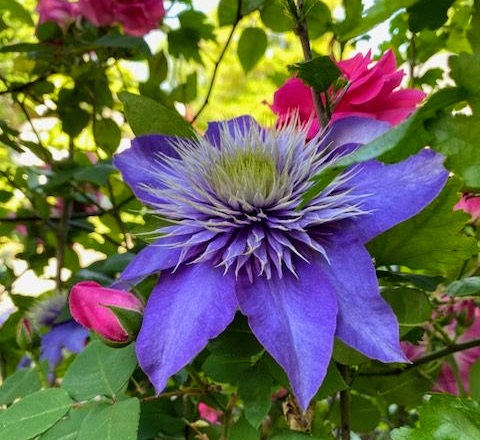
It’s imperative to give your plants and trees a chance to defend themselves by keeping them well-nourished to allow them to fight off pests naturally. For example, be sure to water on a schedule to make sure plants are not stressed by droughts or neglect, especially if you live in a drought prone area.
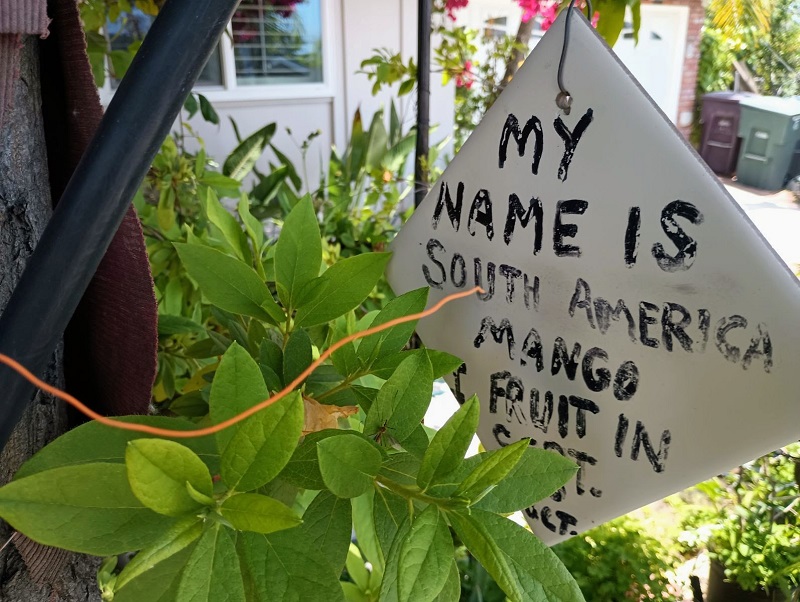
When you can, always add mulch, as this allows moisture to remain in and around roots, feeds the soil and prevents direct exposure from harsh summertime sun and erosion from rain and sprinkler systems. Mulch also suppresses nutrient-robbing weeds that can choke the life from your precious plants.
Organic composting further allows plants to thrive by improving the soil’s ability to maintain moisture and nutrients, while delivering them to plants when needed. The big three cations, NPK, Nitrogen, Phosphorus and Potassium are made available through the enriched soil’s cation exchange capacity, or CEC.
When plants and trees have the strength and vigor needed to fight pests, there is less you need to do to fend off destructive predators.
Physical Defenses
To shore up physical defenses of our garden, we have a used a combination of products, such as netting, fabric, covers, and lighting, as well as natural elements, such as cactus, thorn bushes, rocks, mulch and gravel. Our approach has been to make it physically difficult for pests (primarily rodents in this case) to access desirable food sources, such as young leaves, sprouts and fruit.
Scented Defenses
Another layer of defenses we have been adding over recent months and years is various types of scents that can deter a fairly broad array of “garden predators”. A huge serendipitous win for us was accidentally starting to grow green onions throughout various parts of our garden. Reading about a garden solution is helpful, but seeing one work in real life is extremely encouraging!

This success led us to try other forms of scent-related solutions as additional protection. For example, we now always give scrap pieces of pungent natural ingredients, such as onions, garlic, and ginger, to key plants. These types of strong-scented vegetables are either disliked by many types of pests, or they can confuse or obstruct a garden predator’s ability to smell and find desired food sources.
Targeted Strikes
Of late we have been using more homemade essential oil sprays, such as neem oil, to help resuscitate ailing plants, most often impacted by an infestation of aphids. Again, taking a consistent approach to care will help a plant become sufficiently strong, such that it can easily defend itself naturally.
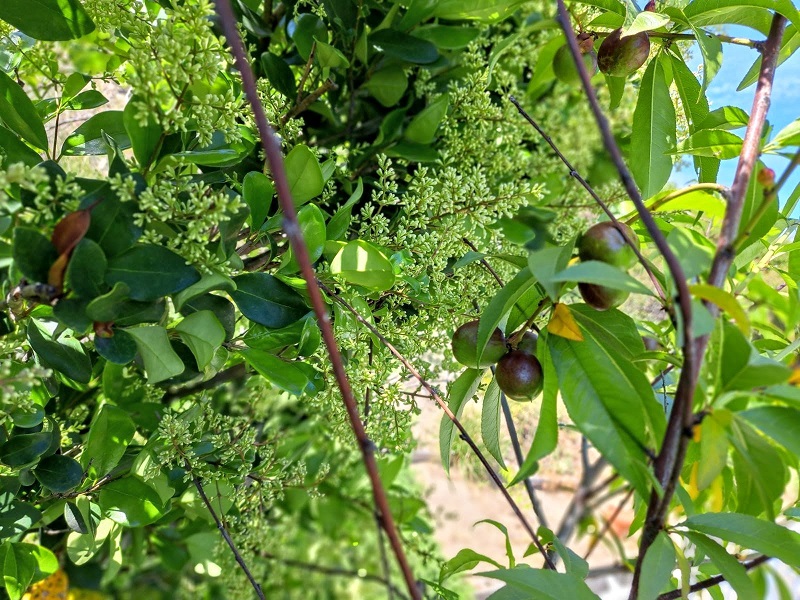
Closeup view of a nectarine tree with young fruit
Benefits of Choosing Natural Remedies for Pest Control for Your Garden
While chemical solutions have been commonly used to combat garden pests, there has been growing interest in turning to natural remedies for pest control. The protracted legal battles around the health ailments surrounding Roundup, for example, has increased consumer awareness of the potential risks of using chemical landscaping solutions.
Several important reasons to choose natural alternatives can be grouped into three categories:
- An Effective Alternative to the Problems of Chemical Pest Control
- A Sustainable & Environmentally-Friendly Approach with Many Benefits
- A Well-Rounded Approach to Pest Management
1. An Effective Alternative to the Problems of Chemical Pest Control
Chemical pesticides may effectively eliminate pests, but they also come with a range of downsides. These chemicals can harm beneficial insects, contaminate soil and water, and pose health risks to humans and animals that can be challenging to isolate. Natural remedies, on the other hand, offer a safer and more sustainable approach.
The risks of using chemical solutions for garden pest control include:
- Pests can develop resistance to chemical pesticides over time, rendering them less effective.
- Chemical pesticides can degrade soil quality over time, disrupting its natural structure and composition.
- Chemical pesticides can be toxic to adults, children, pets and wildlife
- Key wildlife put at risk by chemical treatments include beneficial insects that are vital for any healthy garden.
- The application of chemical solutions may be difficult to isolate and may lead to unintended consequences.
2. A Sustainable & Environmentally-Friendly Approach with Many Benefits
Natural pest control methods utilize elements found in nature, making them inherently more eco-friendly. From using companion plants to repel pests to introducing predators that target specific nuisances, these methods can better maintain the delicate balance of your garden’s micro-ecosystem.
Examples of environmentally-friendly benefits that natural remedies provide include:
- Non-toxic solutions that are safe for adults, children, pets, and wildlife.
- The preservation of beneficial insects, such as essential pollinators and necessary predators
- Natural methods that preserve the intricate and complex interactions within a garden.
- Healthier soil, by facilitating natural systems that nourish the earth for stronger plant growth.
- Long-term sustainability that will require fewer interventions over time
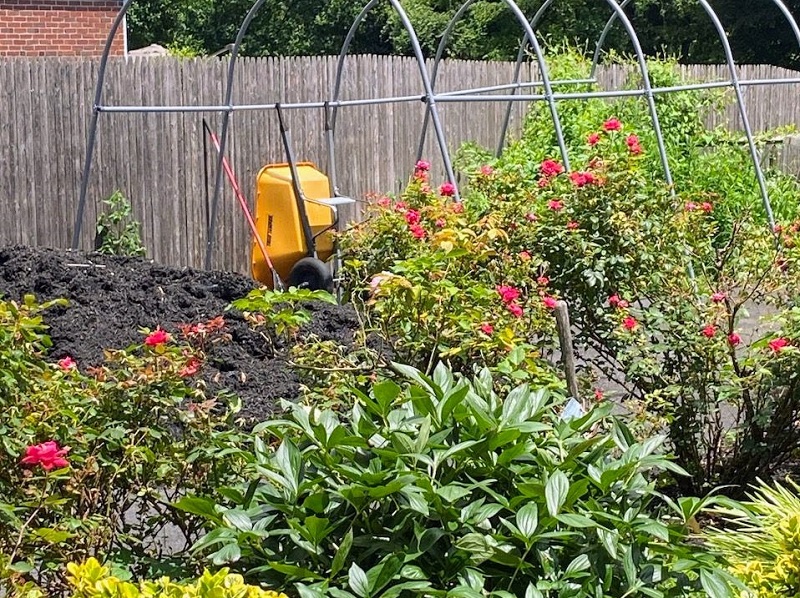
3. A Well-Rounded Approach to Pest Management
When experimenting with individual methods of curbing pests in your garden, it’s important to remember that a holistic approach is often most effective. Combining various natural methods is necessary to create a well-rounded pest management strategy. An example would be incorporating mulching with companion planting, proper watering, and attracting beneficial insects.
Taking a holistic approach to your garden will also help you develop an intuitive understanding of how your garden reacts, and hopefully, thrives with these valuable types of effective treatments.
17 Natural Ways to Protect Your Garden Against Harmful Pests and Insects
Here are twenty effective and eco-friendly ways to help you protect your garden from harmful pests and insects, without having to rely on potentially harmful chemicals.
- Handpicking and Pruning
- Companion Planting
- Neem Oil
- Green Onions
- Vinegar Solution for Weeds
- Garlic and Pepper Spray
- Cinnamon
- Other Essential Oils for Pest Control
- Mulching to Prevent Infestations
- Attract Beneficial Insects
- Intercropping for Pest Reduction
- Beneficial Nematodes
- Floating Row Covers
- Diatomaceous Earth
- Reflective Mulch for Flying Insects
- Beer Traps for Slugs and Snails
- Commercially Available Safe & Natural Pest Control Products
1. Handpicking and Pruning
Regularly inspect your plants and remove any visible pests by hand. Additionally, pruning infected leaves and branches helps prevent the spread of pests and diseases throughout your garden.

Incorporating a daily review of your garden will provide health benefits not only to your garden plants for yourself, as well. Spending peaceful contemplative time outside inspecting your garden will expose you to fresh air and sunshine, while serving as a productive stress diffuser.
This proactive approach to plant care will also help to keep your plants in strong health, which is vitally important against effectively stemming the damage of unwanted pests.
2. Companion Planting
Companion planting is the art of strategically selecting and placing different plants in close proximity to achieve a mutually beneficial outcome. This practice is rooted in the idea that certain plants can enhance the growth of their neighbors by either repelling pests, attracting beneficial insects, or improving soil fertility.
There are many examples of proven companion planting that discourage pests. For instance, marigolds emit a scent that repels insects, making them an excellent companion for vegetables, such as tomatoes, and other flowering plants.
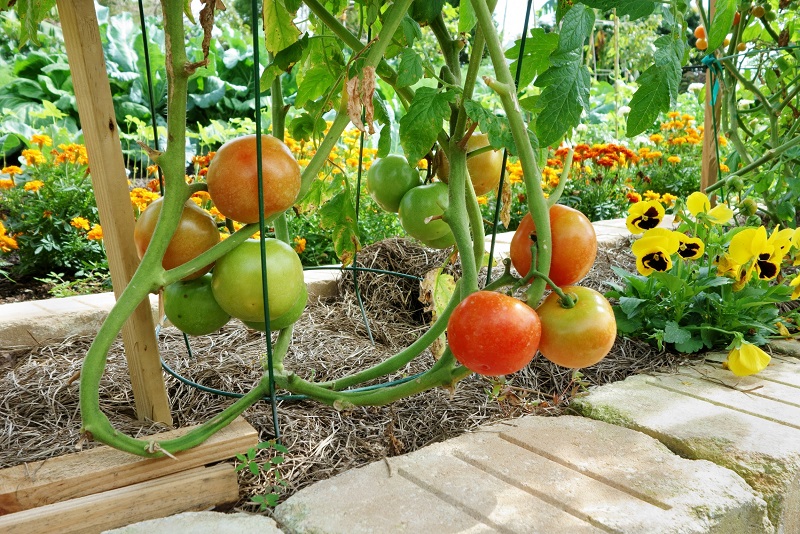
Tomato plants growing near Nasturtiums and Marigolds
Nasturtiums not only add a splash of color to your garden but also act as a natural defense against squash-hungry pests like aphids and squash bugs. Their vibrant presence can help keep these unwanted insects at bay.
Here are several popular examples of pest-resistance companion planting include, with the “distracting” plant listed first:
- Marigolds and Tomatoes
- Nasturtiums and Squash
- Basil and Cabbage
- Chives and Carrots
- Green Onions and Roses
Companion planting can be considered a sub-genre of intercropping.
3. Neem Oil
Neem oil (Azadirachta indica) is a proven enemy of aphids, thrips, and many other insects that literally suck the life out of plants, young leaves buds and fruit.
Derived from the neem tree, neem oil is a powerful natural insect repellent. It disrupts the life cycle of insects and interferes with their feeding and reproduction.
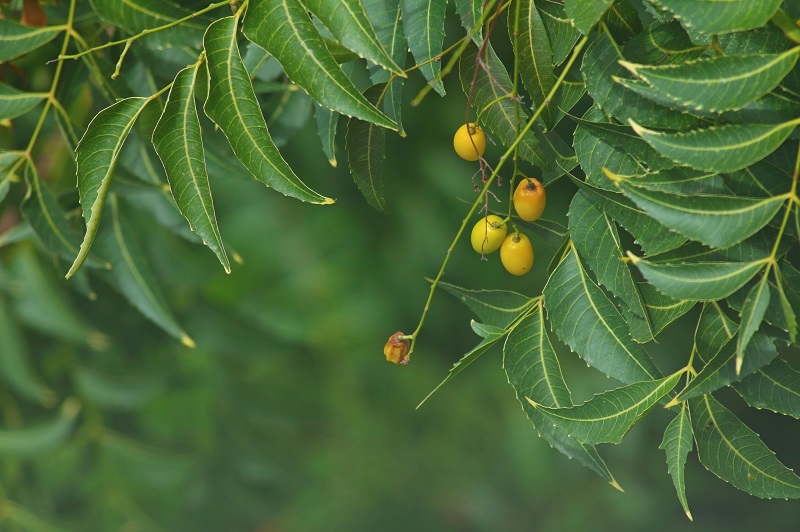
Closeup view of a Neem tree
The Neem tree is indigenous to the Indian subcontinent and has been introduced throughout the tropics as a naturally occurring insecticide. Indian farmers use neem oil, also known as margosa, as their preferred organic insecticide for organic crops.
Neem oil acts by:
- Interfering with the reproductive cycles of many insects
- Inhibiting their feeding ability
- And in many cases, serving as an insecticide on contact
Neem oil can be used throughout the growing season, as it is effective against the entire insect lifecycle, eggs or larvae, pupas and adult stages.
In keeping with our “no kill” philosophy, we spray a neem mixture on young plants and trees at the beginning of the season as a preventative measure. This mixture of neem oil, dishwashing soap and water acts as a deterrent for all pests, as they would rather not smell neem while dining as the smell alone is enough to repel most pests.
A milder mixture of neem can be created by simply diluting neem oil with water and spraying it on your plants as needed.
We have also observed that squirrels, rabbits and other rodents are repelled by neem’s scent.
4. Green Onions
Year after year we attempted to grow roses and gardenias around our home but were defeated by critters who insisted on making a meal of the tender young leaves and buds. At some point we realized that these animals were arriving at night, and were obviously attracted to the smell of the fragrant blooms, which in the California night air, are powerfully fragrant.
Serendipitously, we tossed a spent green onion bulb into a rose planter and it began to grow… very quickly! What we observed is that the rose bush and its flowers finally reached maturity.

The next season we had over a dozen fully formed roses and lots of new shoots growing from the plant’s base. Our critter problem was finally eradicated thanks to our green onions which were, and still are, growing symbiotically in the same planter.
There does not appear to be any competition for nutrients, as the planter is watered daily, and the roses and onions are given banana peels twice a week. In effect, we luckily stumbled upon another example of companion planting.
To make sure that the onion’s scent masks that of the roses, we clip the onions, for consumption, at least once a week.
We have noticed that deer, raccoons, rabbits, squirrels, aphids, and all of the rose’s usual natural predators have all been held at bay, perhaps confused or deterred by the scent of the green onions.
5. Vinegar Solution for Weeds
Weeds can harbor pests and diseases. Create a mixture of vinegar and water and apply it to the base of weeds to naturally eliminate them. However, be cautious when applying vinegar in your garden as it can also affect desirable plants.
Apple cider vinegar works in a similar fashion as white vinegar, but it can be used on more sensitive plants due to having a lower amount of acetic acid.
We experienced a serendipitous benefit of using white vinegar around the perimeter of our house, as our “indoor ant season” was non-existent this summer.
6. Garlic and Pepper Spray
Creating a homemade garlic and pepper spray is another effective way to repel pests. Blend garlic and hot peppers, then mix the solution with water and a drop of dish soap. Spray this mixture on your plants to deter pests with its strong odor.
When using this type of spray, however, be sure to not spray directly onto flowers, as the scent could discourage pollinating insects, such as bees.
Garlic and pepper spray has been noted as being affective against aphids, mites, caterpillars, slugs, mosquitoes, flies and many other types of harmful pests.
7. Cinnamon
Cinnamon is another natural deterrent for squirrels, mice, rabbits and other rodents, as they become overpowered by the potency of the spice’s aroma. Sprinkle cinnamon in your garden and around delicate flowers and shrubs to deter pests, as it will help to disrupt their scent trail.
8. Other Essential Oils for Pest Control
In addition to neem oil, there are several other effective types of essential oils, such as peppermint, lavender, and eucalyptus that have insect-repelling properties. Mix a few drops of these oils with water and spray the solution on your plants to keep pests away with the added benefit of adding a pleasant aroma to your garden.

The secret of eucalyptus, which is known for its highly recognizable sweet sticky scent, is the chemical component called eucalyptol or cineole.
Being familiar with a range of oil options will help you maintain a persistent defense against pests when running out of your preferred or regular homemade pest sprays.
9. Mulching to Prevent Infestations
Mulching not only retains soil moisture and prevents weed growth but also acts as a physical barrier against pests. Certain mulches can discourage pests from nesting or feeding near your plants.
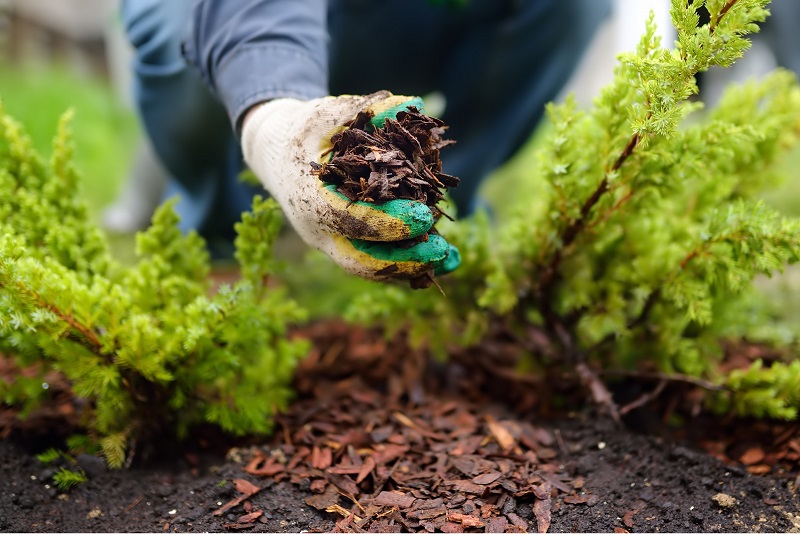
Mulch with materials like straw, wood chips, or leaves to create an obstacle that pests have difficulty crossing. Be sure to choose mulch that is best-suited for the type of pests you wish to hinder.
Popular types of mulch to that are effective at thwarting pest infestation include:
- Cedar
- Cocoa Hull
- Pine Needle
- Straw
- Rubber
- Gravel
- Citrus Peel
- Eucalyptus Mulch
Cedar mulch stands out for its natural insect-repelling properties. The distinct aroma of cedar acts as a barrier against a variety of insects, including ants, moths, and cockroaches. Its oils and compounds are offensive to pests but pleasant to humans, making it an excellent choice for both protection and fragrance.
When applying mulch, ensure that the mulch layer is around 2 to 3 inches thick, while avoiding direct contact with plant stems. Regularly inspect and replace mulch that has decomposed to maintain its effectiveness. Mulch decomposes over time, so you will likely want to replenish it annually to maintain its effectiveness in insect control.
There are misconceptions that mulch can attract pests due to its moisture-retaining properties. While excessive mulch or improper application can create hiding spots for pests, choosing the right type of mulch and maintaining it properly can actually prevent infestations.
You can also create DIY insect-repelling mulch by using ingredients such as citrus peels, cedar shavings, and eucalyptus leaves.
10. Attract Beneficial Insects
Encourage the presence of beneficial insects like ladybugs (AKA lady beetles), lacewings, and parasitic wasps. These insects feed on harmful pests, acting as a natural form of pest control. Planting nectar-rich flowers will attract these beneficial insects to your garden.

Ladybug on verbena leaves eating aphids
Pollen and nectar need to be available throughout the growing season in order to attract different beneficial insects, as well as their corresponding natural enemies.
Ladybugs can also be purchased typically in months of March through August in local nurseries, hardware stores and domestic ecommerce sites. If choosing to purchase ladybugs, advocates for sustainable eco-systems strongly recommend only buying lab-grown ladybugs, as extracting large numbers of ladybugs from the wild can be detrimental to these well-balanced natural habitats.
Neighbors of ours attested that the key to their bountiful young apple tree was purchasing ladybugs soon after being gifted a young wild apple tree from a nearby neighbor’s backyard.
11. Intercropping for Pest Reduction
Intercropping involves planting different crops close together for a specific amount of time for optimized efficiency. Repellent intercropping is the practice of growing plant varieties that are offensive to a specific type of pest in order to deter the pest from reaching its preferred target. This confuses pests, making it harder for them to locate their preferred host plants.
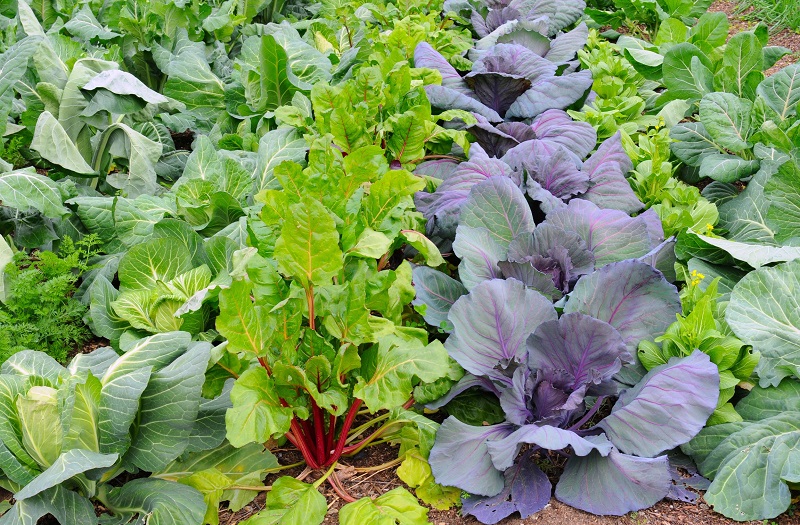
Companion planting is considered a subgenre of intercropping, and differs from other types of intercropping as it makes for more efficient and sustainable usage of a given area. The plant diversity can also promote a healthier ecosystem in your garden.
12. Beneficial Nematodes
Beneficial nematodes are microscopic roundworms that can be added directly to soil. They prey on soil-dwelling pests like grubs and caterpillars, providing a natural and effective solution to underground pest problems.
According to Michigan State University Extension, the majority of nematodes are beneficial and provide the following four benefits:
- Regulate the populations of other soil organisms
- Mineralize nutrients into plant-available forms
- Provide a food source for other soil organisms
- Consume disease-causing organisms
If deciding to incorporate beneficial nematodes in your garden, be sure to research types of nematodes best-suited for your specific type of pest.
Keep in mind that non-beneficial nematodes (also known as root-knot or “plant parasitic nematode”), can cause serious damage to the roots of plants. The good types of nematodes, on the other hand, attack pests, while not negatively impacting the roots of plants.
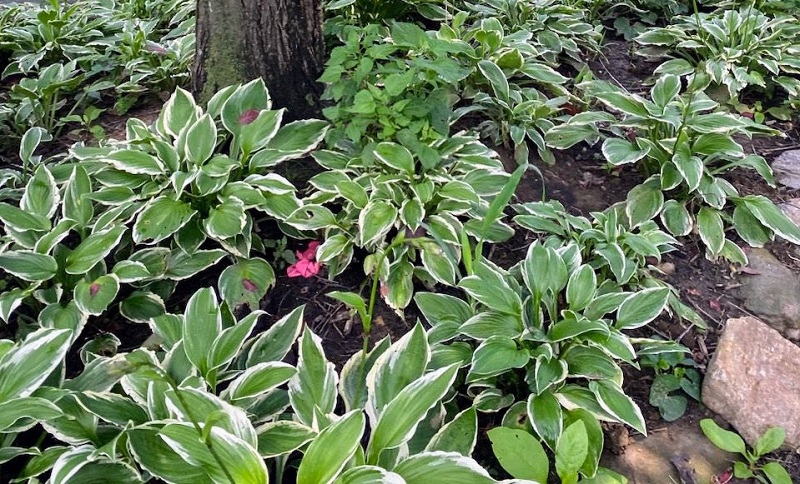
13. Floating Row Covers
Floating row covers, also known as garden fabric, are lightweight fabrics that can be draped over plants to physically block pests while allowing sunlight, water and air to penetrate. These covers create a protective barrier against flying insects. They also provide the additional benefits of serving as a windbreak and extending the growing season by retaining heat.
According to the University of Wisconsin–Madison, floating row covers can effectively guard against the following types of harmful pests:
- Thrips
- Caterpillars
- Fleabeetles
- Onion Maggots
- Seedcorn Maggots
- Cucumber Beetles
- Aster Yellows
Row covers placed on insect-pollinated crops, such as cucumbers or squash, need to be removed during bloom to allow for pollination to occur.
14. Diatomaceous Earth
Diatomaceous earth is a fine powder made from fossilized algae. It acts as a natural barrier that damages the exoskeleton of insects, causing them to dehydrate and die. Sprinkle diatomaceous earth around your plants to create a protective barrier.
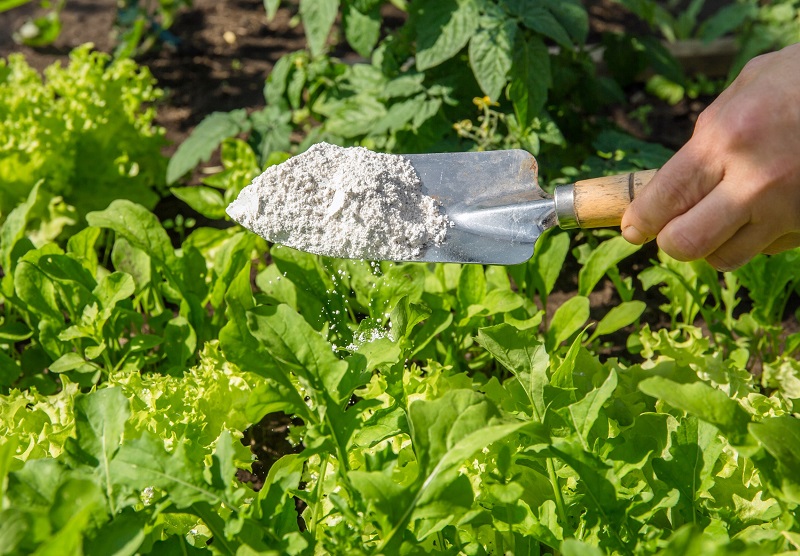
Gardener sprinkles diatomaceous earth powder on vegetable garden
15. Reflective Mulch for Flying Insects
Reflective mulches, like aluminum foil or reflective plastic, disorient flying insects by reflecting sunlight and confusing their navigation. This reduces their ability to locate and attack your plants.
16. Beer Traps for Slugs and Snails
Slugs and snails can devastate a garden, but you can lure them away using beer traps. Bury containers in the soil filled with beer – these pests are attracted to the beer’s aroma, fall in, get drunk and drown.
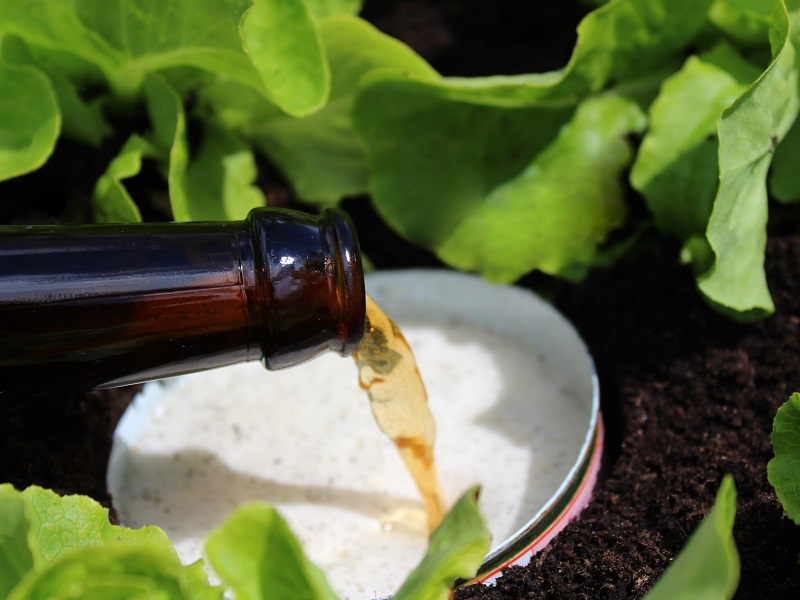
17. Commercially-Available Safe & Natural Pest Control Products
If you lack the time or confidence to create your own home-made natural solutions, there are increasing numbers of natural products readily available for purchase. Two examples are BugMD and Pestie.
Other reputable websites that provide a wide range of safe and natural pest control products include:
Here are few popular natural pest control products, as well:
Natural Ingredients to Keep on Hand to Protect Your Garden
Always remember to keep your “gardener hat” on when coming across yard sales or clearance sales that are literally or practically giving away spices that can be used for your garden. With your garden in mind, you will start to look at “spice hand-me downs” from family, friends and neighbors much differently, as well.
Here is an alphabetical list of all of the various natural ingredients we’ve mentioned that you will want to keep on hand to protect your garden.
| Spices & Ingredients | Oils, Liquids & Sprays | Plants | Flowers & Leaves |
| Banana Peels | Eucalyptus | Basil | Aromatic Asters |
| Black Pepper | Garlic | Cactus | Dandelions |
| Capsaicin/Pepper | Lemon | Chives | Eucalyptus |
| Cinammon | Neem Oil | Cilantro/Coriander | Lavender |
| Cineole | Orange Oil | Dill | Marigolds |
| Clove | Peppermint | Fennel | Nasturtiums |
| Egg Shells | Spearmint | Green Onion | Nectar-Rich Flowers |
| Eucalyptol | Tea Tree | Mustard Family | Queen Anne’s lace |
| Garlic | Vinegar (Any Type) | Rosemary | |
| Ground Chili Pepper | Sunflower | ||
| Lemon | Wild Parsnip | ||
| Lemongrass | Zinnias | ||
| Onion | |||
| Orange Peels | |||
| Rosemary | |||
| Used Coffee Grounds | |||
| Wintergreen |
Popular Natural Remedies for Common Garden Pests
Ants
White vinegar, spearmint, peppermint, or lemon
Aphids
Neem, banana peels, or garlic spray
Fleas
Lavender, lemongrass, or peppermint
Flies
Rosemary, peppermint, eucalyptus, or basil
Mosquitoes
White vinegar, peppermint, lemongrass, or tea tree
Roaches
Tea tree, or eucalyptus
Slugs
Beer traps, or garlic spray
Spiders
White vinegar, spearmint, or peppermint
Termites
Vinegar, beneficial nematodes, diatomaceous earth, orange oil, or orange peels
Conclusion: Embrace Nature’s Wisdom
Choosing natural remedies for pest control in your garden offers a holistic and sustainable approach to maintaining a thriving outdoor space. Protecting your garden from harmful pests and insects can be achieved through a variety of natural and eco-friendly methods, such as: companion planting; natural oils and sprays; beneficial insects; and other creative strategies. By embracing these methods, you can create a healthier and more balanced ecosystem where your plants can flourish without the need for harmful chemicals.
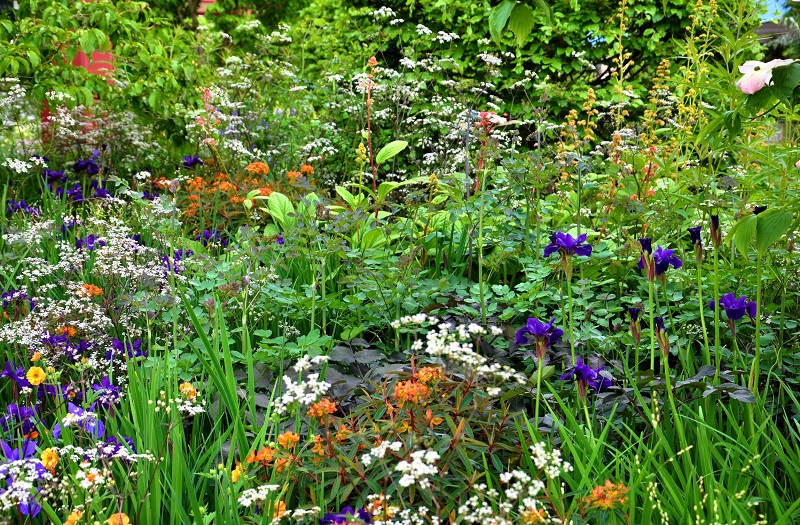
FAQs About Natural Pest Control in Gardens
Are natural pest control methods as effective as chemical pesticides?
Natural pest control methods can be just as effective when properly implemented. While they may require more consistent application, they offer the advantage of being safer for your local environment and beneficial insects.
Can I use essential oils directly on my plants?
It’s recommended to dilute essential oils before applying them to plants to avoid causing damage. Mix a few drops of essential oil with water and test it on a small area of the plant before widespread application.
How often should I apply neem oil to my plants?
Neem oil should be applied every 7 to 14 days, or as needed. Be sure to follow the manufacturer’s instructions for proper dilution and application.
Will reflective mulch harm my pollinators?
Reflective mulch is generally effective against flying pests and shouldn’t impact pollinators, as they tend to visit flowers rather than the ground.
Is it normal for beneficial nematodes to be visible in the soil?
Yes, beneficial nematodes might be visible in the soil. They are harmless to humans, plants, and pets and play a crucial role in controlling soil-dwelling pests.
Will natural remedies harm beneficial insects?
No, natural methods are designed to preserve beneficial insects while targeting pests specifically.
Can I use natural remedies indoors?
Absolutely, many natural remedies can be used indoors as well to control common household pests.
Are natural remedies more time-consuming to apply?
They might require more frequent applications, but the benefits in terms of safety and wellness outweigh the extra effort.
Where can I find the ingredients for these remedies?
Most natural remedies can be found at garden centers, health stores, or online retailers specializing in eco-friendly gardening products.
More Recommended Gardening & Landscaping Articles
- How to Create a Beautiful & Peaceful Outdoor Oasis
- How to Design a Low-Maintenance Garden in 5 Simple Steps
- Best Fruit Trees to Plant by Hardiness Zone
- How to Add Calm to Your Life with a Peaceful Sensory Garden
- 10 Beautiful Houseplants Perfect for Small Rooms and Spaces
- Firescaping: How to Protect Your Home with Fire Resistant Landscapes
- The Traits & Risks of Dangerous Trees: Is Your Property Safe?
- Uber Apps for Lawn Care & Outdoor Services
- Best Garden & Landscaping Shows Now on Amazon Prime
- Pestie: The 411 on the Popular DIY Pest Control Subscription Service
- Pet Waste Removal: An Invaluable Healthy Home Service for Homeowners
- Related Topics: Gardening | Landscaping | Lawn Care | Home Wellness
| Purgula is reader-supported. When you click on links to other sites from our website, we may earn affiliate commissions, at no cost to you. If you find our content to be helpful, this is an easy way for you to support our mission. Thanks! Learn more. |

